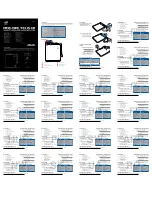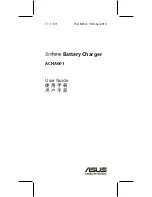
9
• Do not place any containers filled with liquid, vases or plants, on or next to the charger/mains cable.
When these liquids get into the charger (or the plug connections of the mains cable), the charger will be
destroyed and there is a most severe danger of potentially fatal electric shock or fire.
If the charger is operated via the mains cable, first switch off the mains voltage for the mains socket to
which the mains cable is connected (switch off the corresponding circuit breaker or take out the fuse,
then switch off the fault interrupter protection switch (FI circuit breaker) so that the mains socket is
separated from the mains voltage on all poles). Only then unplug the mains plug of the mains cable
from the mains socket.
If the charger is operated via the DC input (11 - 18 V/DC), disconnect the charger from the voltage/
power supply.
Then disconnect the connected rechargeable battery from the charger. Do not use the charger again -
bring it to a specialist workshop.
d) Operation
• The charger may be operated either via the mains voltage (100 - 240 V/AC, 50/60 Hz) or via a
stabilised direct voltage of 11 - 18 V/DC (e.g. via an external vehicle lead battery or a suitable mains
adapter).
Use only one of the two connection types, but never both at once. This may damage the charger.
• Do not wear any metal or conductive materials, such as jewellery (necklaces, bracelets, rings, etc.)
while you are working with the charger or batteries. A short-circuit at the rechargeable battery or charg-
ing cable poses a danger of burns and explosion.
• Never leave the product unattended while operating. Despite a considerable number of protective cir-
cuits, it is impossible to exclude the possibility of malfunctions or problems during the charging process.
• Ensure that there is sufficient ventilation during operation. Never cover up the charger. Leave enough of
a distance (at least 20 cm) between charger and other objects. Overheating causes a danger of fire!
• The charger must only be used to charge (or discharge) rechargeable batteries of types NiMH, NiCd,
LiIon/LiPo/LiFe and lead batteries. Never charge any other rechargeable battery types or non-recharge-
able batteries. There is great danger of fire or explosion!
• Always connect the charging cable to the charger first. Only then must the rechargeable battery be
connected to the charging cable.
When disconnecting, proceed in reverse order - first disconnect the rechargeable battery from the
charging cable, then the charging cable from the charger.
If the order is chosen incorrectly, there may be a short-circuit of the charger plugs; there is a danger of
fire and explosion!
• Only operate the product in moderate climate, never in tropical climate. For more information on ac-
ceptable environmental conditions, see the chapter "Technical Data".
• Never operate the device immediately after it was taken from a cold room to a warm room. The result-
ing condensation may lead to malfunctions or damage!
Let the product reach room temperature before taking it into operation again. This may take several
hours!
Содержание V-CHARGE 50
Страница 1: ...MULTI FUNCTION CHARGER V CHARGE 50 OPERATING INSTRUCTIONS Item No 1416554 VERSION 08 16...
Страница 20: ...20 10 MENU STRUCTURE...
Страница 47: ...47...










































